
LOADING ...
In response to evolving domestic opinion, eMedals Inc has made the conscious decision to remove the presentation of German Third Reich historical artifacts from our online catalogue. For three decades, eMedals Inc has made an effort to preserve history in all its forms. As historians and researchers, we have managed sensitive articles and materials with the greatest of care and respect for their past and present social context. We acknowledge the growing sentiments put forth by the Canadian public and have taken proactive actions to address this opinion.
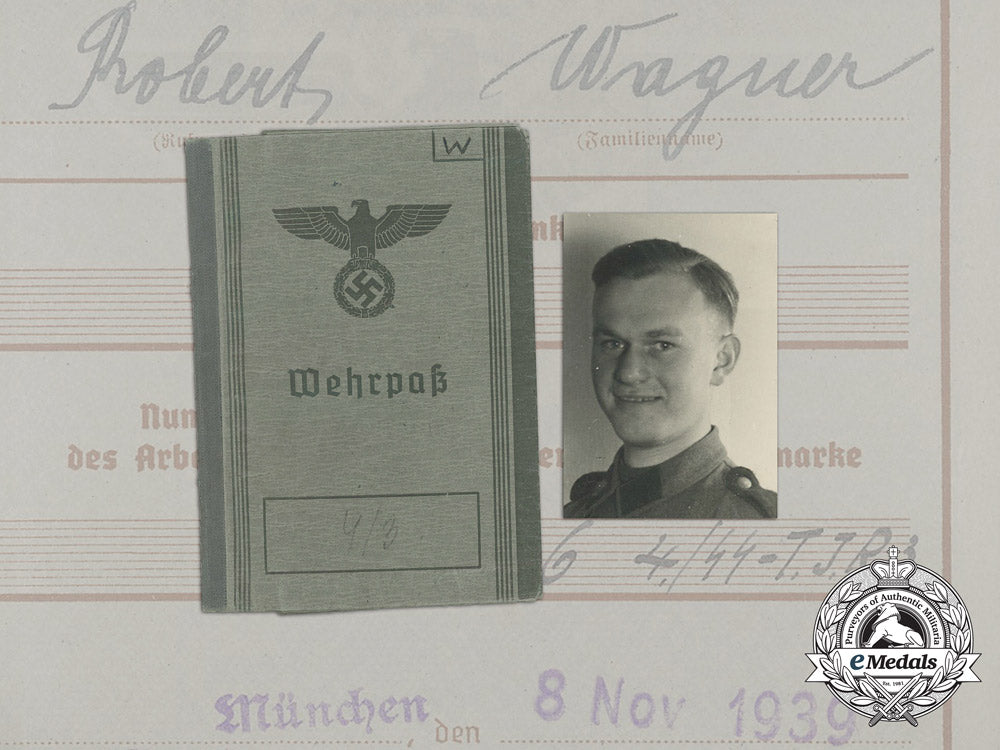
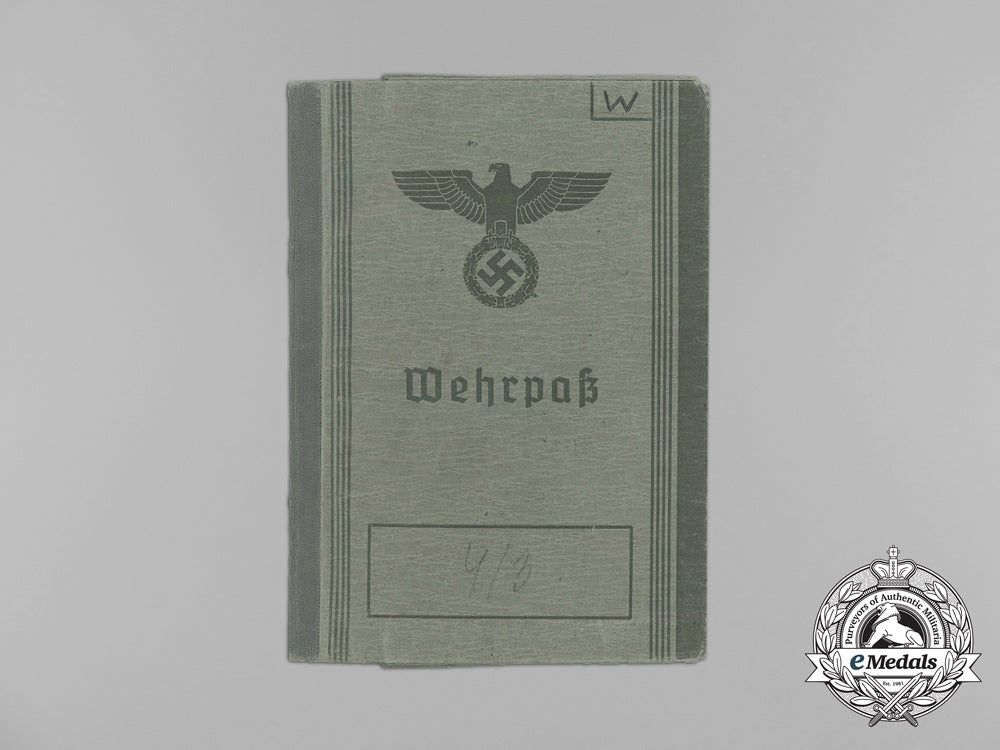
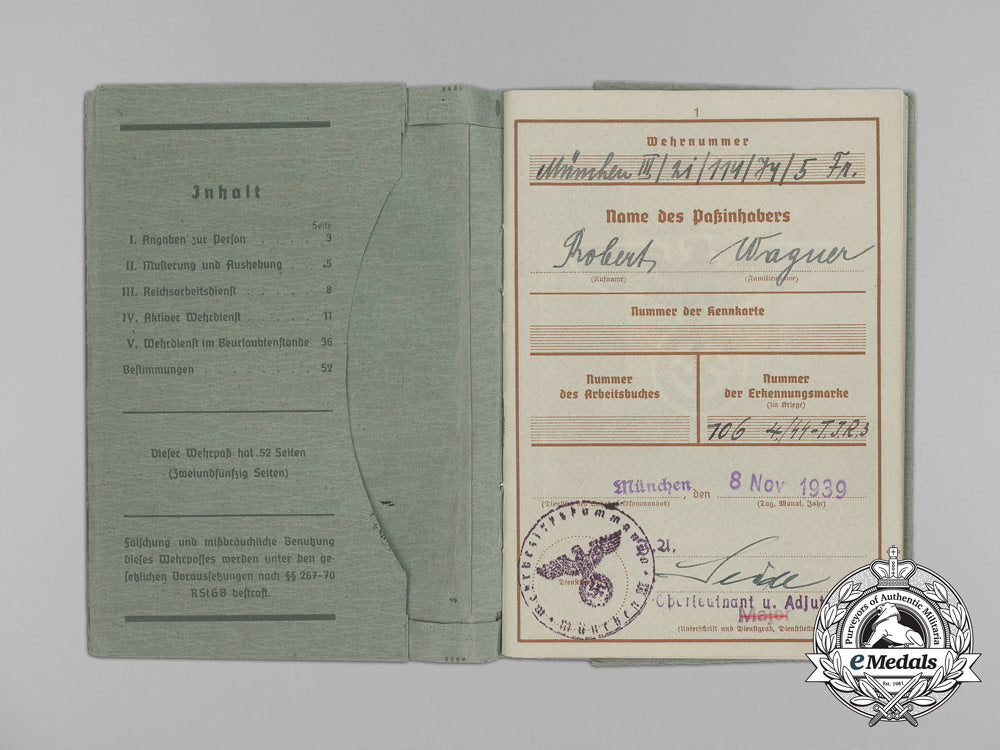
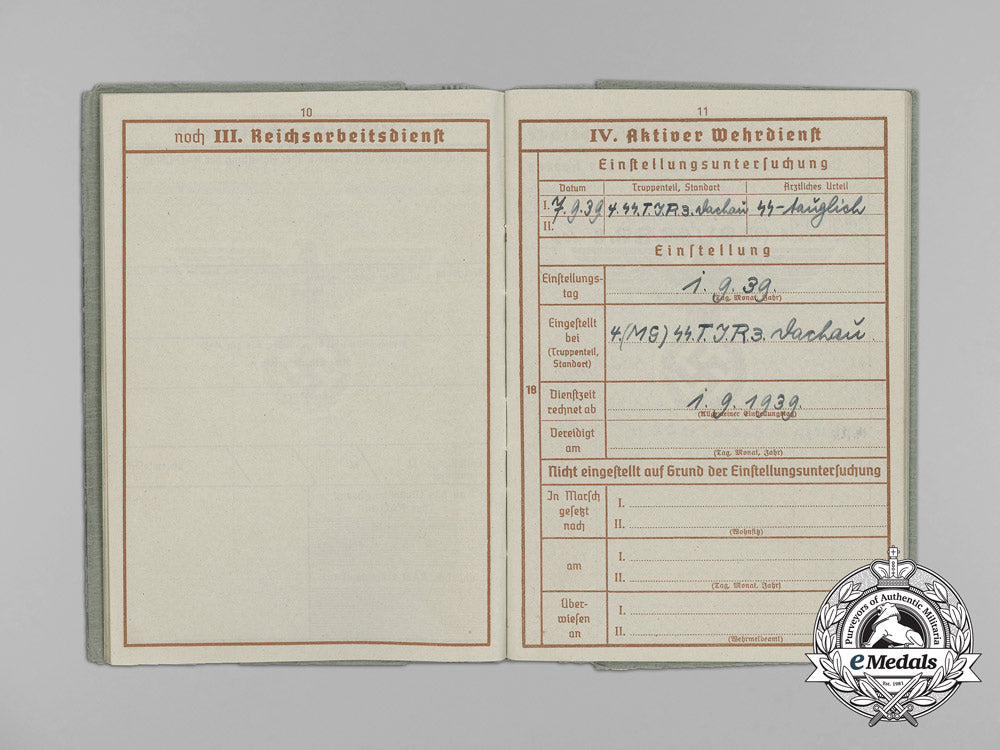
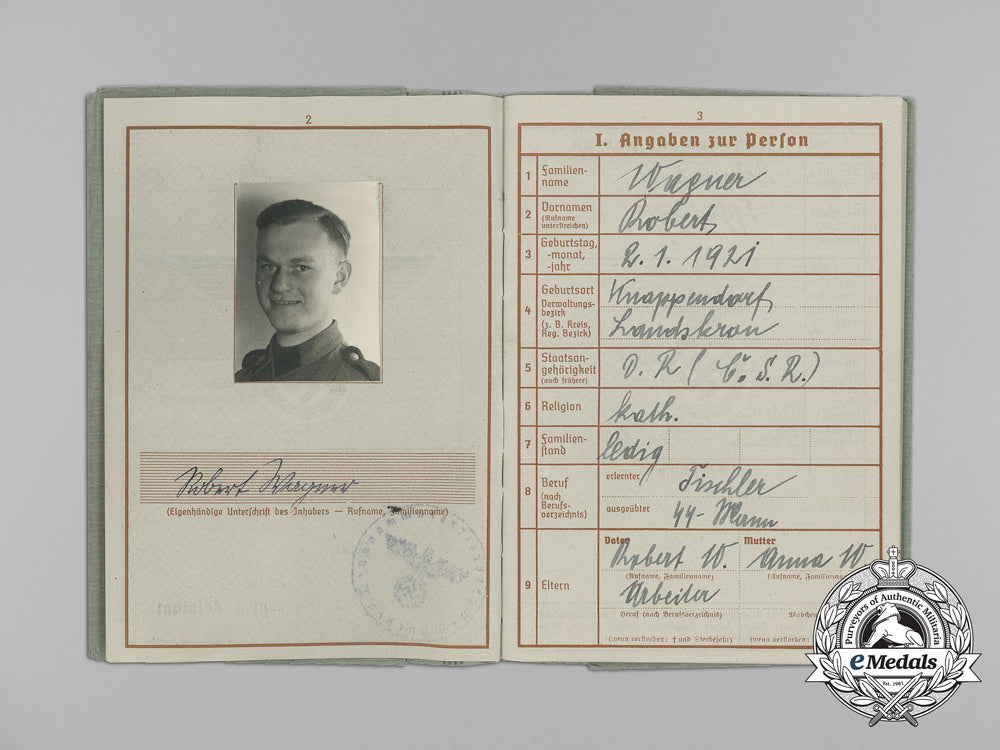
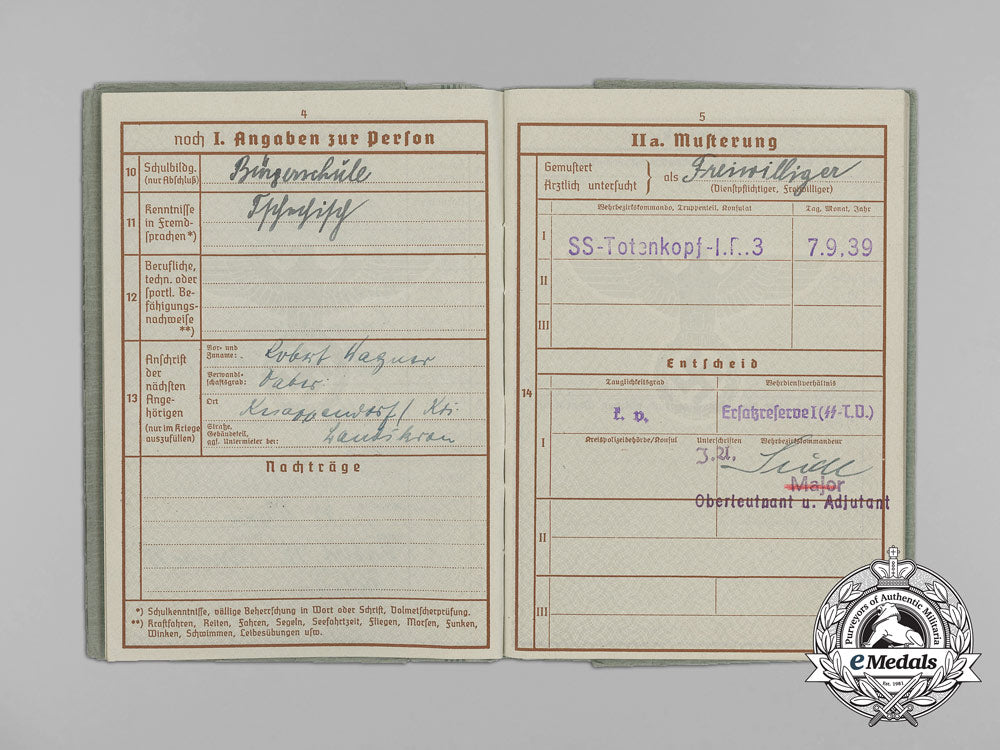
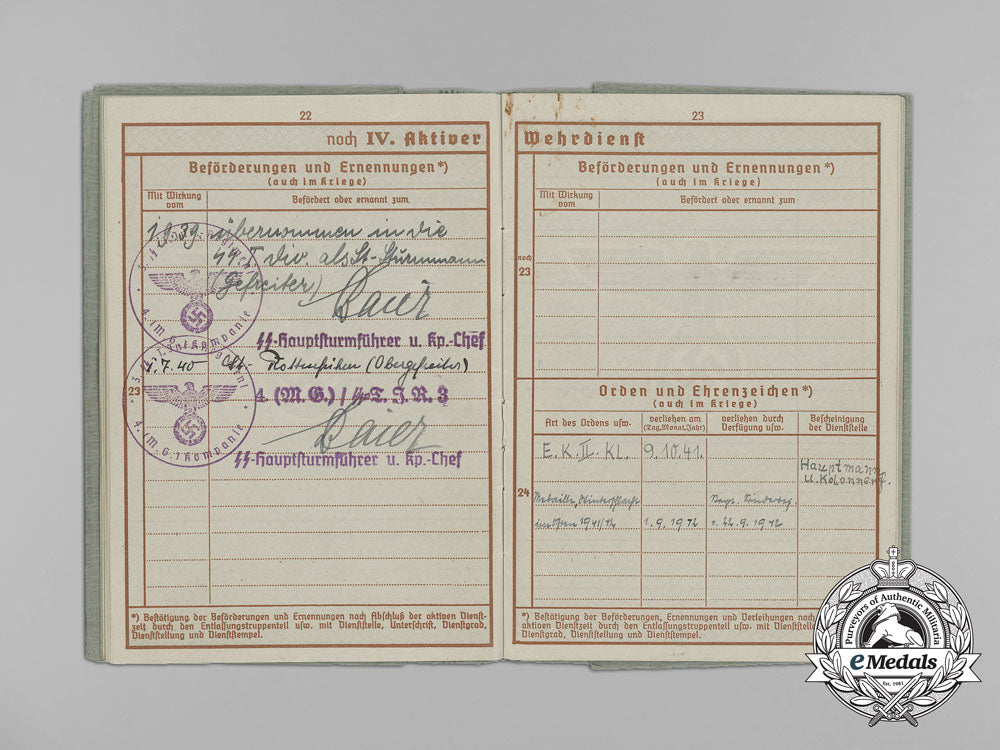
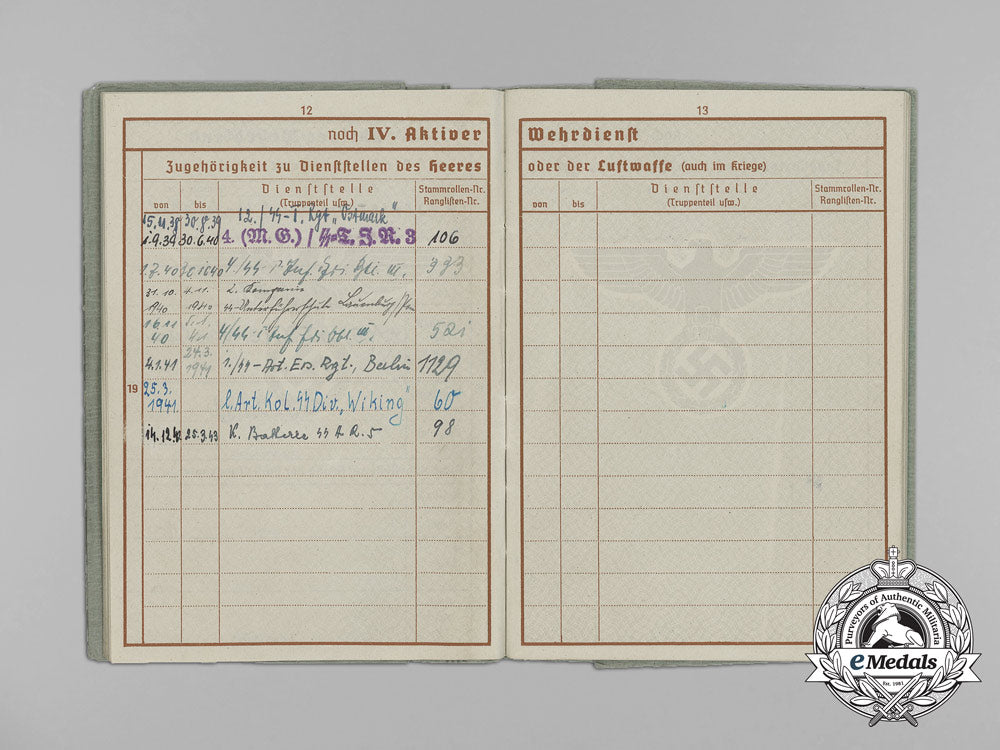

Germany, Ss. An Extensive Document Group To Ss “Totenkopf” & Ss Panzer “Wiking”
Germany, Ss. An Extensive Document Group To Ss “Totenkopf” & Ss Panzer “Wiking”
SKU: ITEM: G30881
Current Bid:
Your Max Bid:
Bid History:
Time Remaining:
Couldn't load pickup availability
Shipping Details
Shipping Details
eMedals offers rapid domestic and international shipping. Orders received prior to 12:00pm (EST) will be shipped on the same business day.* Orders placed on Canadian Federal holidays will be dispatched the subsequent business day. Courier tracking numbers are provided for all shipments. All items purchased from eMedals can be returned for a full monetary refund or merchandise credit, providing the criteria presented in our Terms & Conditions are met. *Please note that the addition of a COA may impact dispatch time.
Shipping Details
eMedals offers rapid domestic and international shipping. Orders received prior to 12:00pm (EST) will be shipped on the same business day.* Orders placed on Canadian Federal holidays will be dispatched the subsequent business day. Courier tracking numbers are provided for all shipments. All items purchased from eMedals can be returned for a full monetary refund or merchandise credit, providing the criteria presented in our Terms & Conditions are met. *Please note that the addition of a COA may impact dispatch time.
Description
Description
It comes with extensive background information and photocopies of the documents, including magnified signatures.
A Wehrpaß (107x149mm, near mint). It is dated to Munich on November 8, 1939.
The promotion page has two signatures of SS-Hauptsturmführer and Company Leader of the 4th Machine Gun Company of SS Totenkopf Infantry Regiment 3, Lorenz Baier. There is another one on the wound page.
An official letter (210x148mm, extremely fine) to Wagner from SS Oberführer and Commander of the SS Artillery Regiment 5, Herbert Otto Gille, winner of the Knight’s Cross with Oak Leaves, Swords, and Diamonds. Wagner is officially being reprimanded for accepting a share of stolen goods on March 15, 1942. The letter is dated to June 9, 1942 and signed in pencil by Gille.
A promotion recommendation (296x209mm, extremely fine), recommending Wagner to become SS-Unterscharführer. The document is dated to March 31, 1941. However, it gives conflicting information, stating that the promotion will take place on April 20, but also that the promotion recommendation has to be issued again four weeks later. The Wehrpaß doesn’t state a promotion to SS-Unterscharführer.
An accompanying letter (211x148mm, very fine), sent to the SS Artillery Replacement Regiment in Munich together with Wagner’s Wehrpaß and 26 other documents upon his admission to a military hospital due to falling ill on January 29, 1943. The document is dated to May 3, 1943, and was received on May 15, 1943. It is signed in pencil by SS-Obersturmführer and Regiment Adjutant, Hans Bünning, a recipient of the German Cross in Gold.
A certificate of term of service (207x147mm, extremely fine), stating that Wagner went into training at the Lower Leader School in Lauenburg from November 1 to 15, 1940, but had to be dismissed due to dental issues. The document is dated to November 18, 1940 and signed in blue ink by an SS-Hauptsturmführer, the name could be Geiger.
A handwritten declaration of debt and a résumé (both 212x297mm, extremely fine). Both are dated to March 31, 1941. In the declaration, Wagner declares under oath that he has no debt.
An evaluation of Wagner (210x296mm, extremely fine) about his performance as a recruiting instructor, which was satisfactory. It is dated to March 24, 1941 and signed by an SS-Hauptsturmführer and the Chief of the 1st Battery of the SS Artillery Replacement Regiment Berlin-Lichterfelde, the name could be Harwat.
Two originals of the same evaluation of Wagner (210x148mm, extremely fine/very fine), dated to April 1, 1941 and signed in blue ink by the Leader of the 13th Convoy of SS Supply Leader 5, SS-Untersturmführer Friedrich Müller. Wagner’s conduct is impeccable. He took part in the campaigns against Poland and France, and was awarded the Wound Badge in Black. He is of strong character and passed a seminar for lower leaders.
An excerpt of Wagner’s Strafbuch (defaulter book) (210x299mm, extremely fine). There is no entry. It is signed once more by Müller.
An evaluation of Wagner (209x148mm, very fine), dated to April 1, 1943 and signed in blue ink by SS-Hauptsturmführer and Chief of K. Battery of the SS Artillery Regiment 5, Walter Pauck (1910–1944, KIA). Wagner’s conduct is that of the average soldier. He is a good driver, but from time to time shows little interest in his duties. He needs strict leadership.
An excerpt of Wagner’s Strafbuch (defaulter book) (210x149mm, extremely fine) dated to Breslau on October 28, 1940 and signed by an SS-Hauptsturmführer, the name is indecipherable. It shows no entries.
An excerpt of Wagner’s Strafbuch (defaulter book) (209x150mm, extremely fine), dated to January 4, 1941 and signed by an SS-Untersturmführer, the name is indecipherable.
An excerpt of Wagner’s Strafbuch (defaulter book) (297x210mm, extremely fine condition), dated to Berlin on March 22, 1941 and signed by an SS-Hauptsturmführer, his name could be Harwat. There are no entries.
An excerpt of Wagner’s Strafbuch (defaulter book) (209x298mm, extremely fine), dated to March 31, 1941, showing no entries.
An excerpt of Wagner’s Strafbuch (defaulter book) (296x210mm, extremely fine) at the SS Lower Leader School in Lauenburg. It has no entries. The document is signed by an SS-Hauptsturmführer, his name could be Geiger.
An SS-Stammkarte (official file) transcript (215x194mm, very fine condition). It is signed by an SS-Hauptsturmführer, the name could be Harwat.
An SS-Stammkarte (official file) (234x198mm, extremely fine), and a Stammkarte transcript (222x194mm, near extremely fine), signed in blue ink by Walter Pauck. He evaluates Wagner’s conduct as “adequate” (school grade D).
A notification of redeployment (209x149mm, extremely fine), dated to Breslau on November 22, 1940 upon the redeployment of Wagner to the 4th Company of SS Totenkopf Infantry Replacement Battalion III. It is signed in pencil by an SS-Hauptsturmführer and the Leader of the Personnel Department, the name is indecipherable.
Two originals of a redeployment sheet (210x297, extremely fine) upon Wagner leaving the SS Supply Leader 5 unit to join the SS Artillery Replacement Regiment Berlin-Lichterfelde on March 27, 1941.
A redeployment sheet (210x294mm, near extremely fine). The reverse is signed by SS-Hauptsturmführer Lorenz Baier.
A redeployment sheet (209x295mm, near mint). The reverse is signed by an SS-Untersturmführer, the name is indecipherable.
An excerpt from the Truppenstammrolle (troop musterroll) (210x297mm, extremely fine). It is dated to Berlin on March 24, 1941 and signed by an SS-Hauptsturmführer, the name could be Harwat.
A driving test certificate (210x146mm, near mint), stating that Wagner has passed his exam on May 22, 1941. The document is signed by an SS-Oberscharführer, the name is indecipherable. The reverse is the admission to take the test, dated to May 2, 1941, it is signed by an SS-Hauptsturmführer, the name is indecipherable.
A training certificate for Wagner’s driving lessons (211x296mm, near extremely fine). It is dated to May 23, 1941, the signature is indecipherable.
A certificate (210x297mm, near extremely fine) with accompanying letter (210x149mm, near extremely fine), stating that Wagner has passed a shortened disbursing officer course. The certificate is dated to March 20, 1941 and signed by an SS-Untersturmführer, the name is indecipherable. The letter is dated to Munich on May 14, 1941, also signed by an SS-Untersturmführer, also indecipherable.
An information sheet concerning the peacetime salary of Wagner (211x295mm, near extremely fine condition).
A salary department of the Waffen-SS instruction sheet (212x148mm, extremely fine), advising Wagner to fill out an accompanying document and send it back, together with his promotion certificate to SS-Rottenführer, so he can receive the appropriate salary. It is dated to Dachau 3 on February 23, 1942 and signed by an SS-Hauptscharführer, the name is indecipherable.
A salary department of the Waffen-SS letter (206x148mm, extremely fine), asking Wagner’s duty station for a copy of his promotion certificate to SS-Rottenführer. The document is dated to Dachau 3 on May 4, 1942.
The answer letter by Wagner’s duty station (211x147mm, extremely fine), sending an excerpt from his Wehrpaß to show his promotion. It is dated to May 23, 1942.
The promotion transcript (210x147mm, extremely fine), stating that Wagner has been promoted to SS-Rottenführer on July 1, 1940. The document is dated to May 23, 1942.
A vacation certificate (295x209mm, near extremely fine), stating that while with the 1st Battery of the SS Artillery Replacement Regiment Wagner took no vacation days. It is signed in blue ink by an SS-Hauptsturmführer, his name could be Harwat.
Footnote: Robert Wagner was born on January 2, 1921 in Knappendorf (Knapovec, today part of the city of Ústí nad Orlicí, Czech Republic). He became a carpenter, but volunteered for service in the SS in November 1938, shortly before his 18th birthday. Wagner joined the 12th Company of the SS Totenkopf Regiment “Ostmark” in Austria, which ran the concentration camp Mauthausen. In mid 1939, however, his unit secretly entered the city of Danzig where they established themselves as a police force and coast guard as the SS Heimwehr (Homeland Defense) Danzig. Wagner was definitely part of this undertaking, since he received the Ehrennadel (Honour Needle) of the SS-Heimwehr Danzig. His next assignment came in September of 1939 with the beginning of the Second War when he was redeployed to the 4th Machine Gun Company of the SS Totenkopf Infantry Regiment 3 Dachau. His unit fought on the Western Front. Wagner was wounded on May 27, 1940, most likely on the second day of the Battle of Dunkirk, when he took a bullet to the shoulder in Le Paradis, on the day of the Le Paradis massacre, the shooting of 97 British and French prisoners by the SS. Wagner spent some time in recovery before a short spell of serving with the 4th Company of the SS Totenkopf Infantry Replacement Battalion III from July to October of 1940. On July 1st, he was also promoted to SS Rottenführer. Because of his new rank, Wagner underwent training at the SS-Unterführerschule (Lower Leader School) Lauenburg, but had to abort due to severe tooth ache that kept him from completing it. He returned to his unit, and was then redeployed in January of 1941 to the 1st Company of the SS Artillery Replacement Regiment in Berlin. However, as early as March 1941, Wagner joined the Light Artillery Convoy SS Division “Wiking”. Soon after, he was on his way to Russia, fighting in the Eastern Campaign. Wagner took part in the advances on Tarnopol (Ternopil, Ukraine) and Zhytomyr (Ukraine). He fought in the Battle of the Sea of Azov, which took place between late September and mid October. On October 9, 1941 Wagner was awarded the Iron Cross 2nd Class. He went on to fight in the Donets area in late 1941. Not much is known about Wagner’s endeavours in 1942, except that he was awarded the Eastern Front Medal on September 1, 1942, and being redeployed to the K. Battery of the SS Artillery Regiment 5 “Wiking” in December. In late January of 1943, he got diarrhoea and had to be admissioned to a hospital. It is unknown if he ever recovered, or if he remained in hospital until his death. Wagner died of cholera on September 13, 1943 in Shevchenkove-Kut (today part of the city of Dobroslav, southern Ukraine) at the young age of 22.
Description
It comes with extensive background information and photocopies of the documents, including magnified signatures.
A Wehrpaß (107x149mm, near mint). It is dated to Munich on November 8, 1939.
The promotion page has two signatures of SS-Hauptsturmführer and Company Leader of the 4th Machine Gun Company of SS Totenkopf Infantry Regiment 3, Lorenz Baier. There is another one on the wound page.
An official letter (210x148mm, extremely fine) to Wagner from SS Oberführer and Commander of the SS Artillery Regiment 5, Herbert Otto Gille, winner of the Knight’s Cross with Oak Leaves, Swords, and Diamonds. Wagner is officially being reprimanded for accepting a share of stolen goods on March 15, 1942. The letter is dated to June 9, 1942 and signed in pencil by Gille.
A promotion recommendation (296x209mm, extremely fine), recommending Wagner to become SS-Unterscharführer. The document is dated to March 31, 1941. However, it gives conflicting information, stating that the promotion will take place on April 20, but also that the promotion recommendation has to be issued again four weeks later. The Wehrpaß doesn’t state a promotion to SS-Unterscharführer.
An accompanying letter (211x148mm, very fine), sent to the SS Artillery Replacement Regiment in Munich together with Wagner’s Wehrpaß and 26 other documents upon his admission to a military hospital due to falling ill on January 29, 1943. The document is dated to May 3, 1943, and was received on May 15, 1943. It is signed in pencil by SS-Obersturmführer and Regiment Adjutant, Hans Bünning, a recipient of the German Cross in Gold.
A certificate of term of service (207x147mm, extremely fine), stating that Wagner went into training at the Lower Leader School in Lauenburg from November 1 to 15, 1940, but had to be dismissed due to dental issues. The document is dated to November 18, 1940 and signed in blue ink by an SS-Hauptsturmführer, the name could be Geiger.
A handwritten declaration of debt and a résumé (both 212x297mm, extremely fine). Both are dated to March 31, 1941. In the declaration, Wagner declares under oath that he has no debt.
An evaluation of Wagner (210x296mm, extremely fine) about his performance as a recruiting instructor, which was satisfactory. It is dated to March 24, 1941 and signed by an SS-Hauptsturmführer and the Chief of the 1st Battery of the SS Artillery Replacement Regiment Berlin-Lichterfelde, the name could be Harwat.
Two originals of the same evaluation of Wagner (210x148mm, extremely fine/very fine), dated to April 1, 1941 and signed in blue ink by the Leader of the 13th Convoy of SS Supply Leader 5, SS-Untersturmführer Friedrich Müller. Wagner’s conduct is impeccable. He took part in the campaigns against Poland and France, and was awarded the Wound Badge in Black. He is of strong character and passed a seminar for lower leaders.
An excerpt of Wagner’s Strafbuch (defaulter book) (210x299mm, extremely fine). There is no entry. It is signed once more by Müller.
An evaluation of Wagner (209x148mm, very fine), dated to April 1, 1943 and signed in blue ink by SS-Hauptsturmführer and Chief of K. Battery of the SS Artillery Regiment 5, Walter Pauck (1910–1944, KIA). Wagner’s conduct is that of the average soldier. He is a good driver, but from time to time shows little interest in his duties. He needs strict leadership.
An excerpt of Wagner’s Strafbuch (defaulter book) (210x149mm, extremely fine) dated to Breslau on October 28, 1940 and signed by an SS-Hauptsturmführer, the name is indecipherable. It shows no entries.
An excerpt of Wagner’s Strafbuch (defaulter book) (209x150mm, extremely fine), dated to January 4, 1941 and signed by an SS-Untersturmführer, the name is indecipherable.
An excerpt of Wagner’s Strafbuch (defaulter book) (297x210mm, extremely fine condition), dated to Berlin on March 22, 1941 and signed by an SS-Hauptsturmführer, his name could be Harwat. There are no entries.
An excerpt of Wagner’s Strafbuch (defaulter book) (209x298mm, extremely fine), dated to March 31, 1941, showing no entries.
An excerpt of Wagner’s Strafbuch (defaulter book) (296x210mm, extremely fine) at the SS Lower Leader School in Lauenburg. It has no entries. The document is signed by an SS-Hauptsturmführer, his name could be Geiger.
An SS-Stammkarte (official file) transcript (215x194mm, very fine condition). It is signed by an SS-Hauptsturmführer, the name could be Harwat.
An SS-Stammkarte (official file) (234x198mm, extremely fine), and a Stammkarte transcript (222x194mm, near extremely fine), signed in blue ink by Walter Pauck. He evaluates Wagner’s conduct as “adequate” (school grade D).
A notification of redeployment (209x149mm, extremely fine), dated to Breslau on November 22, 1940 upon the redeployment of Wagner to the 4th Company of SS Totenkopf Infantry Replacement Battalion III. It is signed in pencil by an SS-Hauptsturmführer and the Leader of the Personnel Department, the name is indecipherable.
Two originals of a redeployment sheet (210x297, extremely fine) upon Wagner leaving the SS Supply Leader 5 unit to join the SS Artillery Replacement Regiment Berlin-Lichterfelde on March 27, 1941.
A redeployment sheet (210x294mm, near extremely fine). The reverse is signed by SS-Hauptsturmführer Lorenz Baier.
A redeployment sheet (209x295mm, near mint). The reverse is signed by an SS-Untersturmführer, the name is indecipherable.
An excerpt from the Truppenstammrolle (troop musterroll) (210x297mm, extremely fine). It is dated to Berlin on March 24, 1941 and signed by an SS-Hauptsturmführer, the name could be Harwat.
A driving test certificate (210x146mm, near mint), stating that Wagner has passed his exam on May 22, 1941. The document is signed by an SS-Oberscharführer, the name is indecipherable. The reverse is the admission to take the test, dated to May 2, 1941, it is signed by an SS-Hauptsturmführer, the name is indecipherable.
A training certificate for Wagner’s driving lessons (211x296mm, near extremely fine). It is dated to May 23, 1941, the signature is indecipherable.
A certificate (210x297mm, near extremely fine) with accompanying letter (210x149mm, near extremely fine), stating that Wagner has passed a shortened disbursing officer course. The certificate is dated to March 20, 1941 and signed by an SS-Untersturmführer, the name is indecipherable. The letter is dated to Munich on May 14, 1941, also signed by an SS-Untersturmführer, also indecipherable.
An information sheet concerning the peacetime salary of Wagner (211x295mm, near extremely fine condition).
A salary department of the Waffen-SS instruction sheet (212x148mm, extremely fine), advising Wagner to fill out an accompanying document and send it back, together with his promotion certificate to SS-Rottenführer, so he can receive the appropriate salary. It is dated to Dachau 3 on February 23, 1942 and signed by an SS-Hauptscharführer, the name is indecipherable.
A salary department of the Waffen-SS letter (206x148mm, extremely fine), asking Wagner’s duty station for a copy of his promotion certificate to SS-Rottenführer. The document is dated to Dachau 3 on May 4, 1942.
The answer letter by Wagner’s duty station (211x147mm, extremely fine), sending an excerpt from his Wehrpaß to show his promotion. It is dated to May 23, 1942.
The promotion transcript (210x147mm, extremely fine), stating that Wagner has been promoted to SS-Rottenführer on July 1, 1940. The document is dated to May 23, 1942.
A vacation certificate (295x209mm, near extremely fine), stating that while with the 1st Battery of the SS Artillery Replacement Regiment Wagner took no vacation days. It is signed in blue ink by an SS-Hauptsturmführer, his name could be Harwat.
Footnote: Robert Wagner was born on January 2, 1921 in Knappendorf (Knapovec, today part of the city of Ústí nad Orlicí, Czech Republic). He became a carpenter, but volunteered for service in the SS in November 1938, shortly before his 18th birthday. Wagner joined the 12th Company of the SS Totenkopf Regiment “Ostmark” in Austria, which ran the concentration camp Mauthausen. In mid 1939, however, his unit secretly entered the city of Danzig where they established themselves as a police force and coast guard as the SS Heimwehr (Homeland Defense) Danzig. Wagner was definitely part of this undertaking, since he received the Ehrennadel (Honour Needle) of the SS-Heimwehr Danzig. His next assignment came in September of 1939 with the beginning of the Second War when he was redeployed to the 4th Machine Gun Company of the SS Totenkopf Infantry Regiment 3 Dachau. His unit fought on the Western Front. Wagner was wounded on May 27, 1940, most likely on the second day of the Battle of Dunkirk, when he took a bullet to the shoulder in Le Paradis, on the day of the Le Paradis massacre, the shooting of 97 British and French prisoners by the SS. Wagner spent some time in recovery before a short spell of serving with the 4th Company of the SS Totenkopf Infantry Replacement Battalion III from July to October of 1940. On July 1st, he was also promoted to SS Rottenführer. Because of his new rank, Wagner underwent training at the SS-Unterführerschule (Lower Leader School) Lauenburg, but had to abort due to severe tooth ache that kept him from completing it. He returned to his unit, and was then redeployed in January of 1941 to the 1st Company of the SS Artillery Replacement Regiment in Berlin. However, as early as March 1941, Wagner joined the Light Artillery Convoy SS Division “Wiking”. Soon after, he was on his way to Russia, fighting in the Eastern Campaign. Wagner took part in the advances on Tarnopol (Ternopil, Ukraine) and Zhytomyr (Ukraine). He fought in the Battle of the Sea of Azov, which took place between late September and mid October. On October 9, 1941 Wagner was awarded the Iron Cross 2nd Class. He went on to fight in the Donets area in late 1941. Not much is known about Wagner’s endeavours in 1942, except that he was awarded the Eastern Front Medal on September 1, 1942, and being redeployed to the K. Battery of the SS Artillery Regiment 5 “Wiking” in December. In late January of 1943, he got diarrhoea and had to be admissioned to a hospital. It is unknown if he ever recovered, or if he remained in hospital until his death. Wagner died of cholera on September 13, 1943 in Shevchenkove-Kut (today part of the city of Dobroslav, southern Ukraine) at the young age of 22.









You May Also Like
International. An Unidentified Air Force Officer's Cap Badge
W6729
Canada, Commonwealth. Two CFD Suez Crisis Period Pair
C6184
Serbia, Kingdom. An Order of the White Eagle, III Class Decoration, Type II
EU23990
Germany, Third Reich. An Order of the German Eagle, I Class Merit Cross with Case, by Gebrüder Godet
G60777
Germany, Third Reich. A Rare Order of the German Eagle, Merit Cross with Breast Star and Case, by Gebrüder Godet
G60778
-
International. An Unidentified Air Force Officer's Cap Badge
W6729
Add to CartRegular price $100 USDRegular price $0 USD Sale price $100 USDUnit price / per -
Canada, Commonwealth. Two CFD Suez Crisis Period Pair
C6184
Add to CartRegular price $60 USDRegular price $0 USD Sale price $60 USDUnit price / per -
Serbia, Kingdom. An Order of the White Eagle, III Class Decoration, Type II
EU23990
Add to CartRegular price $1,650 USDRegular price $0 USD Sale price $1,650 USDUnit price / per -
Germany, Third Reich. An Order of the German Eagle, I Class Merit Cross with Case, by Gebrüder Godet
G60777
Add to CartRegular price $3,450 USDRegular price $0 USD Sale price $3,450 USDUnit price / per -
Germany, Third Reich. A Rare Order of the German Eagle, Merit Cross with Breast Star and Case, by Gebrüder Godet
G60778
Add to CartRegular price $7,650 USDRegular price $0 USD Sale price $7,650 USDUnit price / per
Do you have a similar item you are interested in selling?
Please complete the form and our client care representatives will contact you.
Sell Item






















